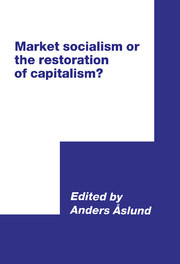Book contents
- Frontmatter
- Contents
- Notes on contributors
- Introduction
- Part I Market socialism revisited
- Part II Economic thinking and policy-making
- 4 The possible new role of market and planning in Poland and Hungary
- 5 Rationalizing the centrally managed economy: the market
- 6 Changes in Soviet economic policy-making in 1989 and 1990
- 7 The restructuring of Soviet industrial ministries since 1985
- Part III Effects of perestroika on Soviet life
- Index
- SELECTED PAPERS FROM THE FOURTH WORLD CONGRESS FOR SOVIET AND EAST EUROPEAN STUDIES, HARROGATE, JULY 1990
6 - Changes in Soviet economic policy-making in 1989 and 1990
from Part II - Economic thinking and policy-making
Published online by Cambridge University Press: 04 August 2010
- Frontmatter
- Contents
- Notes on contributors
- Introduction
- Part I Market socialism revisited
- Part II Economic thinking and policy-making
- 4 The possible new role of market and planning in Poland and Hungary
- 5 Rationalizing the centrally managed economy: the market
- 6 Changes in Soviet economic policy-making in 1989 and 1990
- 7 The restructuring of Soviet industrial ministries since 1985
- Part III Effects of perestroika on Soviet life
- Index
- SELECTED PAPERS FROM THE FOURTH WORLD CONGRESS FOR SOVIET AND EAST EUROPEAN STUDIES, HARROGATE, JULY 1990
Summary
The purpose of this paper is to trace changes in the system of economic policy-making in the Soviet Union from the summer of 1989 until October 1990. The emphasis will rest on the role of institutions and their interaction, but important individuals will also be highlighted. Our interest is in attempts at fundamental economic reform at the central level, elaborated by consecutive reform commissions of the USSR Council of Ministers. Agricultural reform will be by-passed as it has been discussed in other fora. Our current concern is to examine the institutions and people who make policy rather than what they decide. Thus, the substance of economic reform is not covered in this discussion.
First, the paper summarizes the system of economic policy-making established during the second half of 1985. Second, it proceeds to analyse the new economic and political setting that emerged from 1986 to 1989. Third, it presents a review of economic expertise. Finally, the main thrust of this chapter paper is a scrutiny of changes in economic policy-making in the Politburo and the Central Committee (CC) of the CPSU, the Government, the legislature, the Presidential Council, and the economic brain trust, as well as the role of Mikhail Gorbachev in 1989 and 1990.
The legacy of institutional changes since 1985
During the last four months of 1985, important personnel changes took place in the Soviet government, allowing it to expand its policy-making powers at the expense of the CC of the CPSU.
- Type
- Chapter
- Information
- Market Socialism or the Restoration of Capitalism? , pp. 92 - 120Publisher: Cambridge University PressPrint publication year: 1991



